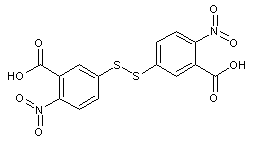
Structural formula
| Business number | 01FT |
|---|---|
| Molecular formula | C14H8N2O8S2 |
| Molecular weight | 396.35 |
| label |
5,5’dithiobis(2-nitrobenzoic acid), 6,6′-dinitro-3,3′-dithiobenzoic acid, 3-Carboxy-4-nitrophenyl disulfide, 6,6′-Dinitro-3,3′-dithiodibenzoic acid, Bis(3-carboxy-4-nitrophenyl)disulfide, DTNB, Ellman’s Reagent, [-SC6H3(NO2)CO2H]2, Enzymes·Proteins·Peptides |
Numbering system
CAS number:69-78-3
MDL number:MFCD00007140
EINECS number:200-714-4
RTECS number:DG9650000
BRN number:1896821
PubChem number:24894189
Physical property data
1. Character:Off-white or yellow powder.
2. Density (g/mL,25/4℃): Unsure
3. Relative vapor density (g/mL ,Air=1): Unsure
4. Melting point (ºC):240-245 (dec.)(lit.)
5. Boiling point (ºC,Normal pressure): Uncertain
6. Boiling point (ºC, 5.2kPa): Unsure
7. Refractive index:Not sure
8. Flash point (ºC): Unsure
9. Specific optical rotation (º): Unsure
10. Autoignition point or ignition temperature (ºC): Unsure
11. Vapor pressure (kPa,25ºC): Unsure
12. Saturated vapor pressure (kPa,60ºC): Unsure
13. Heat of combustion (KJ/mol): Unsure
14. Critical temperature (ºC): Unsure
15. Critical pressure (KPa): Unsure
16. Oil and water (octanol/Log value of water) partition coefficient: Uncertain
17. Explosion limit (%,V/V): Unsure
18. Lower explosion limit (%,V/V): Unsure
19. Solubility: Slightly soluble in acetic acid and water .
Toxicological data
Acute toxicity: mouse abdominal LD50: 2080 mg/kg;
Ecological data
None
Molecular structure data
None
Compute chemical data
1. Reference value for hydrophobic parameter calculation (XlogP): 2.7
2. Number of hydrogen bond donors: 2
3. Number of hydrogen bond acceptors: 10
4. Number of rotatable chemical bonds: 5
5. Number of tautomers: none
6. Topological molecule polar surface area 217
7. Number of heavy atoms: 26
8. Surface charge: 0
9. Complexity: 528
10. Number of isotope atoms: 0
11. Determine the number of atomic stereocenters: 0
12. Uncertain number of atomic stereocenters: 0
13. Determine the number of chemical bond stereocenters: 0
14. Number of uncertain chemical bond stereocenters: 0
15. Number of covalent bond units: 1
Properties and stability
None
Storage method
This product should be sealed and stored in a cool, dry place.
Synthesis method
None
Purpose
For biochemical research. Determination of sulfhydryl groups. Monitoring of organophosphorus pesticide poisoning (cholinesterase assay).
eft; mso-list: l0 level1 lfo1; tab-stops: list 36.0pt; mso-pagination: widow-orphan; mso-margin-top-alt: auto; mso-margin-bottom-alt: auto” align=left> 17. Explosion limit (%,V/V): Unsure
18. Lower explosion limit (%,V/V): Unsure
19. Solubility: Slightly soluble in acetic acid and water .
Toxicological data
Acute toxicity: mouse abdominal LD50: 2080 mg/kg;
Ecological data
None
Molecular structure data
None
Compute chemical data
1. Reference value for hydrophobic parameter calculation (XlogP): 2.7
2. Number of hydrogen bond donors: 2
3. Number of hydrogen bond acceptors: 10
4. Number of rotatable chemical bonds: 5
5. Number of tautomers: none
6. Topological molecule polar surface area 217
7. Number of heavy atoms: 26
8. Surface charge: 0
9. Complexity: 528
10. Number of isotope atoms: 0
11. Determine the number of atomic stereocenters: 0
12. Uncertain number of atomic stereocenters: 0
13. Determine the number of chemical bond stereocenters: 0
14. Number of uncertain chemical bond stereocenters: 0
15. Number of covalent bond units: 1
Properties and stability
None
Storage method
This product should be sealed and stored in a cool, dry place.
Synthesis method
None
Purpose
For biochemical research. Determination of sulfhydryl groups. Monitoring of organophosphorus pesticide poisoning (cholinesterase assay).
mso-ascii-font-family: Arial; mso-hansi-font-family: Arial; mso-font-kerning: 0pt; mso-bidi-font-family: Arial”>For biochemical research. Determination of thiol groups. Monitoring of organophosphorus pesticide poisoning (cholinesterase assay).

 微信扫一扫打赏
微信扫一扫打赏

